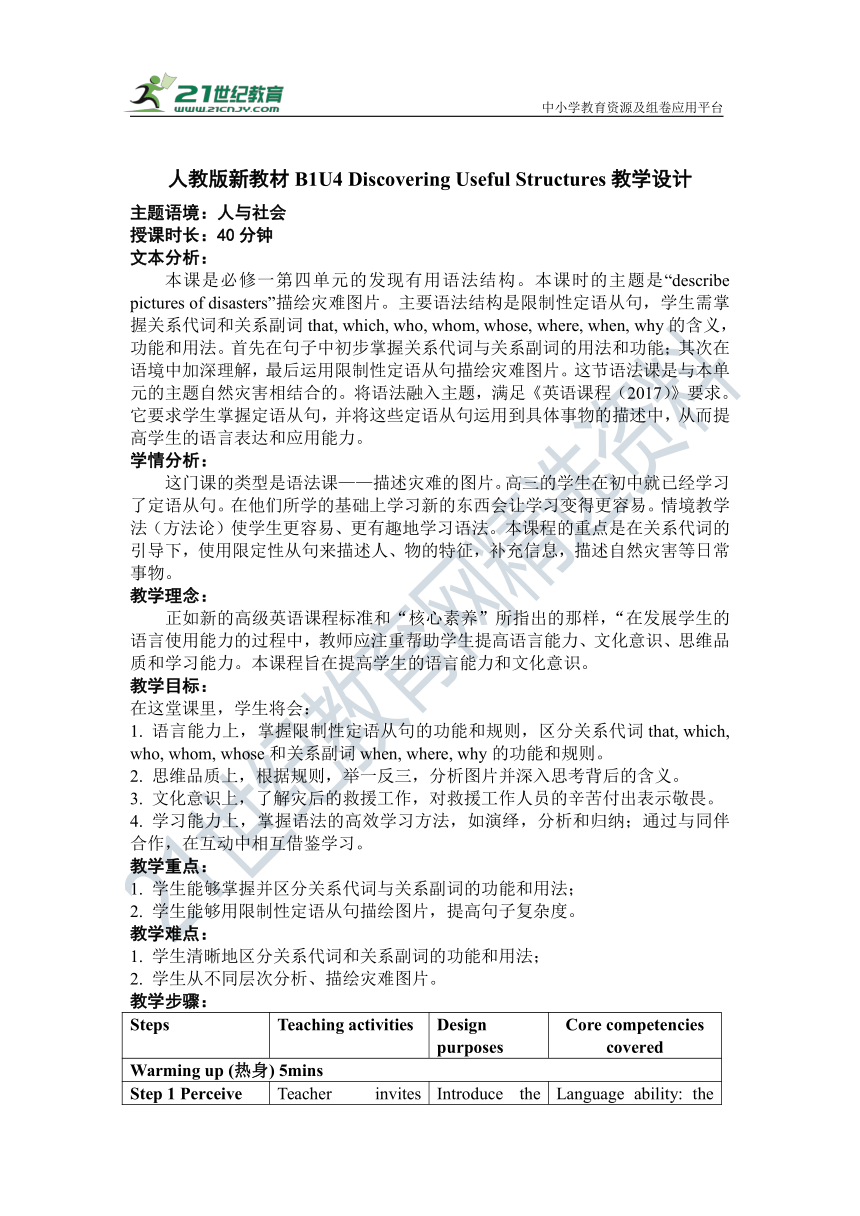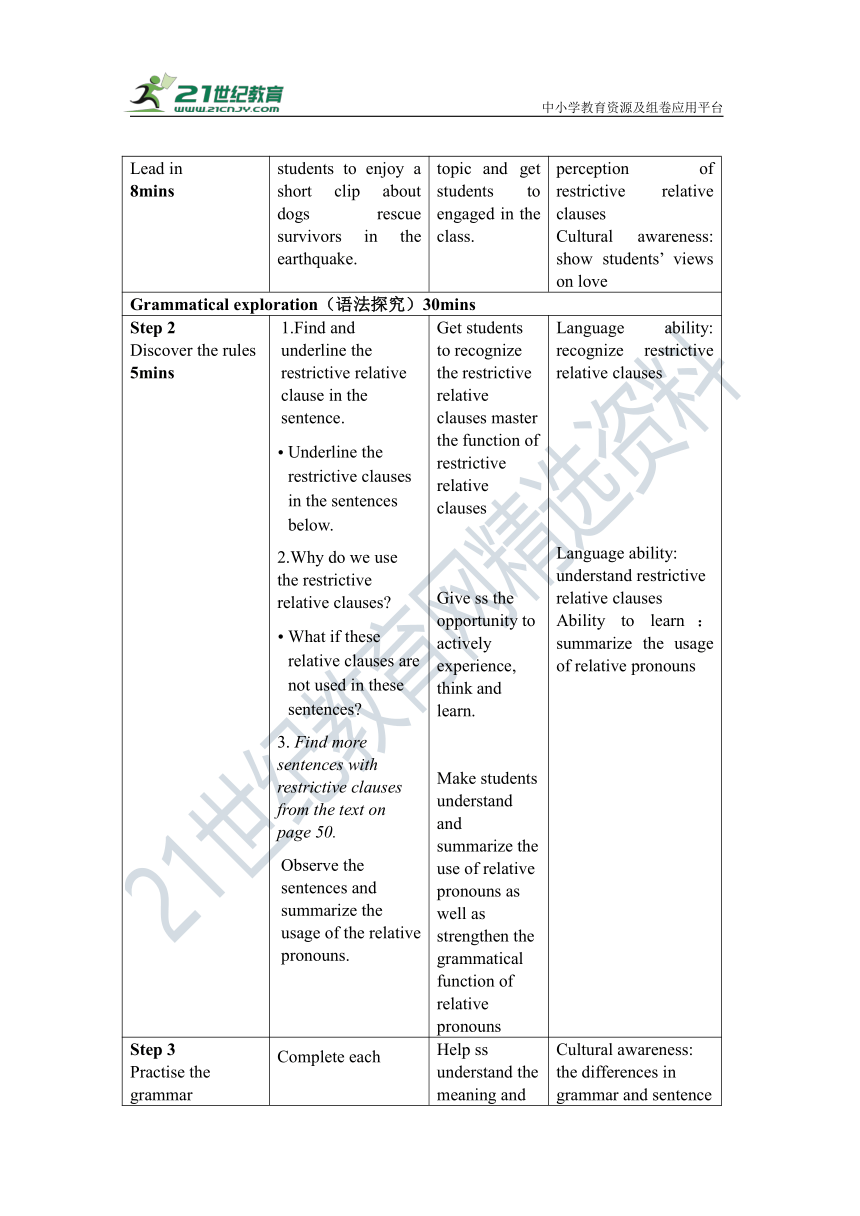人教版(2019)必修第一册 Unit 4 Natural disasters Discovering Useful Structures 教案
文档属性
| 名称 | 人教版(2019)必修第一册 Unit 4 Natural disasters Discovering Useful Structures 教案 |

|
|
| 格式 | docx | ||
| 文件大小 | 137.9KB | ||
| 资源类型 | 试卷 | ||
| 版本资源 | 人教版(2019) | ||
| 科目 | 英语 | ||
| 更新时间 | 2024-09-22 09:11:19 | ||
图片预览


文档简介
中小学教育资源及组卷应用平台
人教版新教材B1U4 Discovering Useful Structures教学设计
主题语境:人与社会
授课时长:40分钟
文本分析:
本课是必修一第四单元的发现有用语法结构。本课时的主题是“describe pictures of disasters”描绘灾难图片。主要语法结构是限制性定语从句,学生需掌握关系代词和关系副词that, which, who, whom, whose, where, when, why的含义,功能和用法。首先在句子中初步掌握关系代词与关系副词的用法和功能;其次在语境中加深理解,最后运用限制性定语从句描绘灾难图片。这节语法课是与本单元的主题自然灾害相结合的。将语法融入主题,满足《英语课程(2017)》要求。它要求学生掌握定语从句,并将这些定语从句运用到具体事物的描述中,从而提高学生的语言表达和应用能力。
学情分析:
这门课的类型是语法课——描述灾难的图片。高三的学生在初中就已经学习了定语从句。在他们所学的基础上学习新的东西会让学习变得更容易。情境教学法(方法论)使学生更容易、更有趣地学习语法。本课程的重点是在关系代词的引导下,使用限定性从句来描述人、物的特征,补充信息,描述自然灾害等日常事物。
教学理念:
正如新的高级英语课程标准和“核心素养”所指出的那样,“在发展学生的语言使用能力的过程中,教师应注重帮助学生提高语言能力、文化意识、思维品质和学习能力。本课程旨在提高学生的语言能力和文化意识。
教学目标:
在这堂课里,学生将会:
语言能力上,掌握限制性定语从句的功能和规则,区分关系代词that, which, who, whom, whose和关系副词when, where, why的功能和规则。
思维品质上,根据规则,举一反三,分析图片并深入思考背后的含义。
文化意识上,了解灾后的救援工作,对救援工作人员的辛苦付出表示敬畏。
学习能力上,掌握语法的高效学习方法,如演绎,分析和归纳;通过与同伴合作,在互动中相互借鉴学习。
教学重点:
学生能够掌握并区分关系代词与关系副词的功能和用法;
学生能够用限制性定语从句描绘图片,提高句子复杂度。
教学难点:
学生清晰地区分关系代词和关系副词的功能和用法;
学生从不同层次分析、描绘灾难图片。
教学步骤:
Steps Teaching activities Design purposes Core competencies covered
Warming up (热身) 5mins
Step 1 Perceive Lead in 8mins Teacher invites students to enjoy a short clip about dogs rescue survivors in the earthquake. Introduce the topic and get students to engaged in the class. Language ability: the perception of restrictive relative clauses Cultural awareness: show students’ views on love
Grammatical exploration(语法探究)30mins
Step 2 Discover the rules 5mins 1.Find and underline the restrictive relative clause in the sentence. Underline the restrictive clauses in the sentences below. 2.Why do we use the restrictive relative clauses What if these relative clauses are not used in these sentences 3. Find more sentences with restrictive clauses from the text on page 50. Observe the sentences and summarize the usage of the relative pronouns. Get students to recognize the restrictive relative clauses master the function of restrictive relative clauses Give ss the opportunity to actively experience, think and learn. Make students understand and summarize the use of relative pronouns as well as strengthen the grammatical function of relative pronouns Language ability: recognize restrictive relative clauses Language ability: understand restrictive relative clauses Ability to learn:summarize the usage of relative pronouns
Step 3 Practise the grammar 7 mins Complete each sentence with relative pronouns. Then translate the sentences into Chinese. Help ss understand the meaning and features of English sentences with their native language. Cultural awareness: the differences in grammar and sentence patterns between English and Chinese
Step 4 Application Describe pictures of disasters 10mins Write one or two sentences with restrictive clauses to describe these pictures. Get students to describe pictures of natural disasters and strengthen the grammatical function of restrictive relative clauses. Cultural awareness: understand some major natural disasters at home and abroad from the perspective of historical events, and establish a sense of disaster prevention and self-protection. Quality of thinking: cultivate students’ innovative thinking in the process of describing pictures.
Step 5 deep thinking Discover love and circulate love 8 mins Love is a sniffing dog that helps find survivors. Love is a bottle of milk that can feed the baby. Love is also a tent that soldiers put up for victims Stimulate students’ affection for sufferers Have the awareness and attitude to actively respond to natural disasters and think positively from multiple angles as well as reduce psychological sufferings caused by disasters Quality of thinking:Disasters are merciless but we Chinese have love Quality of thinking:positive, helpful, supportive, self-healing
Assignment (Homework) 2mins
Compulsory assignment: Write a short passage to describe the rescue work after the natural disaster. Use restrictive relative clauses as much as possible.
板书设计:
Restrictive Relative Clauses
Relative pronoun
For things: that which For People: that who which For possessive: whose
人教版新教材B1U4 Discovering Useful Structures教学设计
主题语境:人与社会
授课时长:40分钟
文本分析:
本课是必修一第四单元的发现有用语法结构。本课时的主题是“describe pictures of disasters”描绘灾难图片。主要语法结构是限制性定语从句,学生需掌握关系代词和关系副词that, which, who, whom, whose, where, when, why的含义,功能和用法。首先在句子中初步掌握关系代词与关系副词的用法和功能;其次在语境中加深理解,最后运用限制性定语从句描绘灾难图片。这节语法课是与本单元的主题自然灾害相结合的。将语法融入主题,满足《英语课程(2017)》要求。它要求学生掌握定语从句,并将这些定语从句运用到具体事物的描述中,从而提高学生的语言表达和应用能力。
学情分析:
这门课的类型是语法课——描述灾难的图片。高三的学生在初中就已经学习了定语从句。在他们所学的基础上学习新的东西会让学习变得更容易。情境教学法(方法论)使学生更容易、更有趣地学习语法。本课程的重点是在关系代词的引导下,使用限定性从句来描述人、物的特征,补充信息,描述自然灾害等日常事物。
教学理念:
正如新的高级英语课程标准和“核心素养”所指出的那样,“在发展学生的语言使用能力的过程中,教师应注重帮助学生提高语言能力、文化意识、思维品质和学习能力。本课程旨在提高学生的语言能力和文化意识。
教学目标:
在这堂课里,学生将会:
语言能力上,掌握限制性定语从句的功能和规则,区分关系代词that, which, who, whom, whose和关系副词when, where, why的功能和规则。
思维品质上,根据规则,举一反三,分析图片并深入思考背后的含义。
文化意识上,了解灾后的救援工作,对救援工作人员的辛苦付出表示敬畏。
学习能力上,掌握语法的高效学习方法,如演绎,分析和归纳;通过与同伴合作,在互动中相互借鉴学习。
教学重点:
学生能够掌握并区分关系代词与关系副词的功能和用法;
学生能够用限制性定语从句描绘图片,提高句子复杂度。
教学难点:
学生清晰地区分关系代词和关系副词的功能和用法;
学生从不同层次分析、描绘灾难图片。
教学步骤:
Steps Teaching activities Design purposes Core competencies covered
Warming up (热身) 5mins
Step 1 Perceive Lead in 8mins Teacher invites students to enjoy a short clip about dogs rescue survivors in the earthquake. Introduce the topic and get students to engaged in the class. Language ability: the perception of restrictive relative clauses Cultural awareness: show students’ views on love
Grammatical exploration(语法探究)30mins
Step 2 Discover the rules 5mins 1.Find and underline the restrictive relative clause in the sentence. Underline the restrictive clauses in the sentences below. 2.Why do we use the restrictive relative clauses What if these relative clauses are not used in these sentences 3. Find more sentences with restrictive clauses from the text on page 50. Observe the sentences and summarize the usage of the relative pronouns. Get students to recognize the restrictive relative clauses master the function of restrictive relative clauses Give ss the opportunity to actively experience, think and learn. Make students understand and summarize the use of relative pronouns as well as strengthen the grammatical function of relative pronouns Language ability: recognize restrictive relative clauses Language ability: understand restrictive relative clauses Ability to learn:summarize the usage of relative pronouns
Step 3 Practise the grammar 7 mins Complete each sentence with relative pronouns. Then translate the sentences into Chinese. Help ss understand the meaning and features of English sentences with their native language. Cultural awareness: the differences in grammar and sentence patterns between English and Chinese
Step 4 Application Describe pictures of disasters 10mins Write one or two sentences with restrictive clauses to describe these pictures. Get students to describe pictures of natural disasters and strengthen the grammatical function of restrictive relative clauses. Cultural awareness: understand some major natural disasters at home and abroad from the perspective of historical events, and establish a sense of disaster prevention and self-protection. Quality of thinking: cultivate students’ innovative thinking in the process of describing pictures.
Step 5 deep thinking Discover love and circulate love 8 mins Love is a sniffing dog that helps find survivors. Love is a bottle of milk that can feed the baby. Love is also a tent that soldiers put up for victims Stimulate students’ affection for sufferers Have the awareness and attitude to actively respond to natural disasters and think positively from multiple angles as well as reduce psychological sufferings caused by disasters Quality of thinking:Disasters are merciless but we Chinese have love Quality of thinking:positive, helpful, supportive, self-healing
Assignment (Homework) 2mins
Compulsory assignment: Write a short passage to describe the rescue work after the natural disaster. Use restrictive relative clauses as much as possible.
板书设计:
Restrictive Relative Clauses
Relative pronoun
For things: that which For People: that who which For possessive: whose
